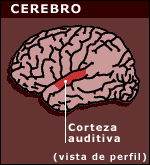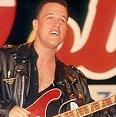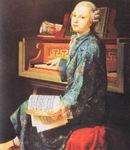Mi cerebro derecho.
En concordancia con lo establecido en recientes estudios cerebrales,
con lo establecido en recientes estudios cerebrales,  GianMarco, no dispondría de un volumen cerebral promedio, su corteza cerebral derecha auditiva, sería más grande, disponiendo de un 30 %, adicional de neuronas, más que el promedio de personas, a consecuencia de su trabajo como prolífico compositor musical. En la circonvolución auditiva cerebral transversa de Henschl (Fig.de la izquierda), se gestaría el incremento neuronal, en la mayoría de músicos activos.
GianMarco, no dispondría de un volumen cerebral promedio, su corteza cerebral derecha auditiva, sería más grande, disponiendo de un 30 %, adicional de neuronas, más que el promedio de personas, a consecuencia de su trabajo como prolífico compositor musical. En la circonvolución auditiva cerebral transversa de Henschl (Fig.de la izquierda), se gestaría el incremento neuronal, en la mayoría de músicos activos.
 con lo establecido en recientes estudios cerebrales,
con lo establecido en recientes estudios cerebrales,  GianMarco, no dispondría de un volumen cerebral promedio, su corteza cerebral derecha auditiva, sería más grande, disponiendo de un 30 %, adicional de neuronas, más que el promedio de personas, a consecuencia de su trabajo como prolífico compositor musical. En la circonvolución auditiva cerebral transversa de Henschl (Fig.de la izquierda), se gestaría el incremento neuronal, en la mayoría de músicos activos.
GianMarco, no dispondría de un volumen cerebral promedio, su corteza cerebral derecha auditiva, sería más grande, disponiendo de un 30 %, adicional de neuronas, más que el promedio de personas, a consecuencia de su trabajo como prolífico compositor musical. En la circonvolución auditiva cerebral transversa de Henschl (Fig.de la izquierda), se gestaría el incremento neuronal, en la mayoría de músicos activos.El autor del trabajo Peter Schneider, de la Universidad de Heildelberg, agrega que este abundamiento neuronal es congénito, aunque susceptible de ser mejorado y maximizado por el entorno. De otro lado, Bengtsson et al, -ver link 1-, que han estudiado a personas de distintas edades practicantes de piano, concluye que existe una correlación positiva entre la práctica continua del piano y la organización de los tractos fibrosos nerviosos. En niños, los tractos fibrosos piramidales (relacionados con movimientos de dedos y manos), tienden a hacerse más densos y extensos, en tanto que en adolescentes y adultos, la práctica pianística en ciertos períodos críticos, promueve plasticidad regional en diversos tractos nerviosos mielinizados. Es decir, acá se cumple aquello de que : "la función hace al órgano".
Lo que no s e sabe bién, es si este abundamiento neuronal es congénito o, se adquiere durante la vida, a expensas de prácticas musicales continuas. Ciertas investigaciones avalan una u, otra vertiente. Peter Schneider de la Universidad de Heildelberg, sostiene que el talento musical es heredado (ciertas personas portarían ciertos "genes musicales", ausentes en otros). Aaron Williamom, del Colegio Real de Musica del reino Unido, piensa lo contrario : solo la práctica diaria, incrementa el número de neuronas. Al respecto, Gay relata que Amadeus Mozart, aprendió a tocar el clavicénbalo en forma autodidacta a los 3 años y que a los 5, en apenas 30 minutos, dominó una serie de minuetos y tríos, anotados en el Notebuch de su hermana Nannerl de 12 años, también aficionada musical. Más tarde, a los 5, compuso su primer concerto, llegando a dominar el violín a los 7 años. Aunque la precocidad de Gianmarco podría ser heredada, el entorno familiar (su señor padre -ganador del Festival musical de Ancón-, también era compositor), debe haber puesto su cuota.
e sabe bién, es si este abundamiento neuronal es congénito o, se adquiere durante la vida, a expensas de prácticas musicales continuas. Ciertas investigaciones avalan una u, otra vertiente. Peter Schneider de la Universidad de Heildelberg, sostiene que el talento musical es heredado (ciertas personas portarían ciertos "genes musicales", ausentes en otros). Aaron Williamom, del Colegio Real de Musica del reino Unido, piensa lo contrario : solo la práctica diaria, incrementa el número de neuronas. Al respecto, Gay relata que Amadeus Mozart, aprendió a tocar el clavicénbalo en forma autodidacta a los 3 años y que a los 5, en apenas 30 minutos, dominó una serie de minuetos y tríos, anotados en el Notebuch de su hermana Nannerl de 12 años, también aficionada musical. Más tarde, a los 5, compuso su primer concerto, llegando a dominar el violín a los 7 años. Aunque la precocidad de Gianmarco podría ser heredada, el entorno familiar (su señor padre -ganador del Festival musical de Ancón-, también era compositor), debe haber puesto su cuota.
Hoy sabemos que los tonos musicales, impresionan áreas especificas cerebrales. Es decir que una salsa, un merengue o, un reggaeton golpearán con más fuerza ciertas áreas específicas del cerebro auditivo, en tanto que las tonos de una balada o, un requiem, impresionarán a, otras. Por cierto aunque el cerebro izquierdo,dispone de cierta cuota musical : distinción rápida y grosera de los tonos musicales, parece estar más dedicado al procesamiento de fonemas y palabras. De otro lado, el cerebro derecho, aunque mas lento, es más musical, siendo muy sensible a los cambios de frecuencia tonal. No obstante toda digestión musical involucra en forma simultánea e interconectada a ambos cerebros. El dominio perceptivo, de los sistemas anteriores, le permite a los grandes compositores musicales manipular a la audiencia y crear soberbios hits musicales.
A explicar los conocimientos musicales referidos anteriormente, han contribuido dos vertientes:1) la técnica de la resonancia magnética nuclear, que permite visualizar "in vivo", el funcionamiento cerebral asociado a diversos estímulos musicales y 2) el estudio musical de personas con lesiones cerebrales. Un caso, que ha aportado en demasía a nuestro conocimiento, es el del músico Maurice Ravel, quien dejó de componer, no perdiendo sin embargo su capacidad para escuchar y apreciar música, tras sufrir una lesión cerebral.
Links 1-http://www.nature.com/neuro/journal/vaop/ncurrent/abc/nn1516.html
2-Gay Peter.1999.Wolfgang Amadeus Mozart.Biblioteca ABC Protagonistas de la historia. Lipper Publications.Editada en Lima por diario :La República.
 e sabe bién, es si este abundamiento neuronal es congénito o, se adquiere durante la vida, a expensas de prácticas musicales continuas. Ciertas investigaciones avalan una u, otra vertiente. Peter Schneider de la Universidad de Heildelberg, sostiene que el talento musical es heredado (ciertas personas portarían ciertos "genes musicales", ausentes en otros). Aaron Williamom, del Colegio Real de Musica del reino Unido, piensa lo contrario : solo la práctica diaria, incrementa el número de neuronas. Al respecto, Gay relata que Amadeus Mozart, aprendió a tocar el clavicénbalo en forma autodidacta a los 3 años y que a los 5, en apenas 30 minutos, dominó una serie de minuetos y tríos, anotados en el Notebuch de su hermana Nannerl de 12 años, también aficionada musical. Más tarde, a los 5, compuso su primer concerto, llegando a dominar el violín a los 7 años. Aunque la precocidad de Gianmarco podría ser heredada, el entorno familiar (su señor padre -ganador del Festival musical de Ancón-, también era compositor), debe haber puesto su cuota.
e sabe bién, es si este abundamiento neuronal es congénito o, se adquiere durante la vida, a expensas de prácticas musicales continuas. Ciertas investigaciones avalan una u, otra vertiente. Peter Schneider de la Universidad de Heildelberg, sostiene que el talento musical es heredado (ciertas personas portarían ciertos "genes musicales", ausentes en otros). Aaron Williamom, del Colegio Real de Musica del reino Unido, piensa lo contrario : solo la práctica diaria, incrementa el número de neuronas. Al respecto, Gay relata que Amadeus Mozart, aprendió a tocar el clavicénbalo en forma autodidacta a los 3 años y que a los 5, en apenas 30 minutos, dominó una serie de minuetos y tríos, anotados en el Notebuch de su hermana Nannerl de 12 años, también aficionada musical. Más tarde, a los 5, compuso su primer concerto, llegando a dominar el violín a los 7 años. Aunque la precocidad de Gianmarco podría ser heredada, el entorno familiar (su señor padre -ganador del Festival musical de Ancón-, también era compositor), debe haber puesto su cuota.Hoy sabemos que los tonos musicales, impresionan áreas especificas cerebrales. Es decir que una salsa, un merengue o, un reggaeton golpearán con más fuerza ciertas áreas específicas del cerebro auditivo, en tanto que las tonos de una balada o, un requiem, impresionarán a, otras. Por cierto aunque el cerebro izquierdo,dispone de cierta cuota musical : distinción rápida y grosera de los tonos musicales, parece estar más dedicado al procesamiento de fonemas y palabras. De otro lado, el cerebro derecho, aunque mas lento, es más musical, siendo muy sensible a los cambios de frecuencia tonal. No obstante toda digestión musical involucra en forma simultánea e interconectada a ambos cerebros. El dominio perceptivo, de los sistemas anteriores, le permite a los grandes compositores musicales manipular a la audiencia y crear soberbios hits musicales.
A explicar los conocimientos musicales referidos anteriormente, han contribuido dos vertientes:1) la técnica de la resonancia magnética nuclear, que permite visualizar "in vivo", el funcionamiento cerebral asociado a diversos estímulos musicales y 2) el estudio musical de personas con lesiones cerebrales. Un caso, que ha aportado en demasía a nuestro conocimiento, es el del músico Maurice Ravel, quien dejó de componer, no perdiendo sin embargo su capacidad para escuchar y apreciar música, tras sufrir una lesión cerebral.
Links 1-http://www.nature.com/neuro/journal/vaop/ncurrent/abc/nn1516.html
2-Gay Peter.1999.Wolfgang Amadeus Mozart.Biblioteca ABC Protagonistas de la historia. Lipper Publications.Editada en Lima por diario :La República.
My right brain.
In agreement with the established thing in recent cerebral studies, GianMarco, would not have a cerebral volume average, its auditory right cerebral crust, would be greater, having 30 %, additional of neurons, more than the average people, as a result of its work as prolífic musical composer. In the transverse brain auditory circonvolution of Henschl (Fig. left), would be developed the neuronal increase, in most active musicians.
The author of the work Peter Schneider, of the University of Heildelberg, adds that this neuronal abundance is congenital, although susceptible to be improved and to be maximized by the surroundings. Of another side, Bengtsson et al, -see :Link 1-, who have studied people : piano-practitioners of different ages, concludes that a positive correlation between the continuous practice of the piano and the organization of the nervous fibrous tractos exists. In children, the piramidals fibrous tracts (related to movements of fingers and hands), tend to become denser and extensive, whereas in adolescents and adults, the piano practice in certain critical periods, promotes regional plasticity in several mielynated nervous tracts. That is to say :"the function does to the organ".
What we don't know well, is if this neuronal abundance is congenital or, it is acquired during the life, to expenses of continuous musical practices. Certain investigations guarantee one or, another slope. Peter Schneider of the University of Heildelberg, maintains that the musical talent is inherited (certain people would carry certain "musical genes", absentees in others). Aaron Williamom, of the Real School of Music of the United Kingdom, thinks the opposite: single the daily practice, increases the number of neurons. On the matter, Gay relates that Amadeus Mozart, learned to touch clavicémbalo in self-taught form to the 3 years and that to the 5, in hardly 30 minutes, dominated a series of minuets and trios, written down in the Notebuch of their Nannerl sister of 12 years, also become fond of music. But late, to the 5, he composed his first concerto, getting to dominate the violin to the 7 years. Although the precocity of Gianmarco could be inherited, the familiar surroundings (his gentleman father - winning of the musical Festival of Ancon -, also was composer), must have put its quota.Today we know that the musical tones, impress specific areas of the brain. It is to say that salsa, merengue or, reggaeton will strike with more force certain specific areas of the auditory brain, whereas the tones of a ballad or, a requiem, make an impression in others. By the way although the left brain, has certain musical quota: fast and crude distinction of the musical tones, seems to be more dedicated to the processing of phonemes and words. Of another side, the right, although slow, is more musical, being very sensible to the changes of pitch frequency. Despite this, all musical digestion involves in simultaneous and interconnected form both brains. The perceptive mastering of the previous systems, allows the great musical composers to manipulate the audience and to create great musical hits. To explain the referred musical knowledge previously, have contributed two slopes:1) the technique of the nuclear magnetic resonance, that allows to visualize "in alive", the cerebral operation associated to diverse musical stimuli and 2) the musical study of people with brain injuries. A case, that has contributed to our knowledge too much, is the one of the musician Maurice Ravel, that let compose, not losing nevertheless its capacity to listen to and to appreciate music, after suffering a cerebral injury.
In agreement with the established thing in recent cerebral studies, GianMarco, would not have a cerebral volume average, its auditory right cerebral crust, would be greater, having 30 %, additional of neurons, more than the average people, as a result of its work as prolífic musical composer. In the transverse brain auditory circonvolution of Henschl (Fig. left), would be developed the neuronal increase, in most active musicians.
The author of the work Peter Schneider, of the University of Heildelberg, adds that this neuronal abundance is congenital, although susceptible to be improved and to be maximized by the surroundings. Of another side, Bengtsson et al, -see :Link 1-, who have studied people : piano-practitioners of different ages, concludes that a positive correlation between the continuous practice of the piano and the organization of the nervous fibrous tractos exists. In children, the piramidals fibrous tracts (related to movements of fingers and hands), tend to become denser and extensive, whereas in adolescents and adults, the piano practice in certain critical periods, promotes regional plasticity in several mielynated nervous tracts. That is to say :"the function does to the organ".
What we don't know well, is if this neuronal abundance is congenital or, it is acquired during the life, to expenses of continuous musical practices. Certain investigations guarantee one or, another slope. Peter Schneider of the University of Heildelberg, maintains that the musical talent is inherited (certain people would carry certain "musical genes", absentees in others). Aaron Williamom, of the Real School of Music of the United Kingdom, thinks the opposite: single the daily practice, increases the number of neurons. On the matter, Gay relates that Amadeus Mozart, learned to touch clavicémbalo in self-taught form to the 3 years and that to the 5, in hardly 30 minutes, dominated a series of minuets and trios, written down in the Notebuch of their Nannerl sister of 12 years, also become fond of music. But late, to the 5, he composed his first concerto, getting to dominate the violin to the 7 years. Although the precocity of Gianmarco could be inherited, the familiar surroundings (his gentleman father - winning of the musical Festival of Ancon -, also was composer), must have put its quota.Today we know that the musical tones, impress specific areas of the brain. It is to say that salsa, merengue or, reggaeton will strike with more force certain specific areas of the auditory brain, whereas the tones of a ballad or, a requiem, make an impression in others. By the way although the left brain, has certain musical quota: fast and crude distinction of the musical tones, seems to be more dedicated to the processing of phonemes and words. Of another side, the right, although slow, is more musical, being very sensible to the changes of pitch frequency. Despite this, all musical digestion involves in simultaneous and interconnected form both brains. The perceptive mastering of the previous systems, allows the great musical composers to manipulate the audience and to create great musical hits. To explain the referred musical knowledge previously, have contributed two slopes:1) the technique of the nuclear magnetic resonance, that allows to visualize "in alive", the cerebral operation associated to diverse musical stimuli and 2) the musical study of people with brain injuries. A case, that has contributed to our knowledge too much, is the one of the musician Maurice Ravel, that let compose, not losing nevertheless its capacity to listen to and to appreciate music, after suffering a cerebral injury.
Enviame un comment.Gracias. Send me a comment.Thank you.



.+Photo+Author.jpg)



1 Comments:
Wonderful and informative web site. I used information from that site its great. Runco lcd http://www.weight-loss-52.info license plate frames gate openers sofas cheap butalbital Rising 15 year old tennis stars Tire rack co Mitsubishi movie projectors Wireless calling plans +denver Italian cooking school vacation getaway Tip on cleaning the dishwasher Xenical online pharmacy phentermine meridia Gambling 2bpoker Nissan 93 pathfinder and fuel injector
Post a Comment
<< Home